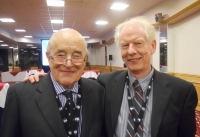Torquay 2-4 March 2011 The British Hip Society (BHS) was conceived during the 1989 Autumn meeting of the British Orthopaedic Association (BOA) when Hugh Phillips suggested the idea to Michael Freeman and Robin Ling. They were both enthusiastic and the first meeting took place at the Royal Society of Medicine during the following November.
Torquay 2-4 March 2011
The British Hip Society (BHS) was conceived during the 1989 Autumn meeting of the British Orthopaedic Association (BOA) when Hugh Phillips suggested the idea to Michael Freeman and Robin Ling. They were both enthusiastic and the first meeting took place at the Royal Society of Medicine during the following November.
Robin Ling (pictured with Professor Ian Clarke from DARF, Los Angeles) attended the 2011 meeting where his founding ideas were acknowledged. He has seen the British Hip Society thrive and expand to its present day status.
I co-chaired the Podium Presentations of Scientific Papers session with Martyn Lovell, where 7 exceptional presentations were given on the subject of Resurfacing Arthroplasty.
It was noted by Alister Hart (Imperial College London) that pseudotumours occur in both well and poorly positioned acetabular sockets.
At the meeting a proposal was raised by Peter Howard that the British Hip Society support the use of Aspirin as the agent of choice to reduce the risk of thrombosis following hip surgery. The vote from the floor was unanimously in favour of this proposal.
Large Head Metal on Metal Total Hip Replacements were discussed in a session where papers were delivered showing higher than anticipated early failure rates. These ranged from 21% revision rate at 4 years to 49% at 6 years for the ASR XL device. Other devices were shown to have higher revision rates at around 12-15% at 5 years.
As in the resurfacing arthroplasties, increased wear of the metal on metal bearing surfaces have been noted. However, wear and/or corrosion has now also been identified at the trunnion-taper junction between the head and the stem.
Patients present with pain and radiographs may show loosening and osteolysis, cobalt and chromium ions may be elevated, and ultrasound and MRI scans may show fluid collections, cystic and/or solid masses.
This was a most solemn note on which to end an exceptional and well attended British Hip Society meeting.
This leaves me to personally thank the outgoing President, Graham Gie and to welcome John Hodgkinson as the new President.


